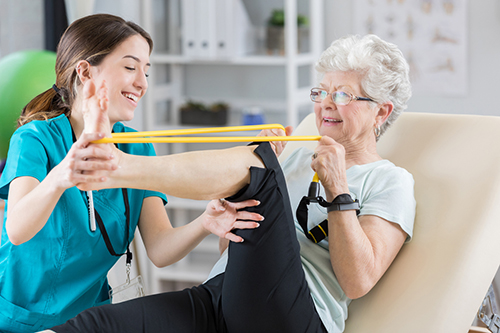
Physical therapy plays a very important role in the recovery process after a surgery. It helps patients heal optimally and return to their active lifestyles faster.
With most orthopedic surgical procedures, early mobilization—getting the part moving as soon as possible—will speed healing. Generally, early mobilization starts with gentle range-of-motion exercises and then moves on to stretching and strengthening exercise, while taking care to prevent injury. When you are ready, weights may be added to your exercise routine to further strengthen the supporting muscles.
As the surgical incisions heal, scar tissue forms which may cause tightness or stiffness. That's why stretching and strengthening exercises are so important. You should continue to stretch the muscles daily as the first part of your warm-up before exercising.
When planning your rehabilitation program with a health care professional, remember that progression is the key principle. You will start with just a few movements or exercises and then gradually increase the intensity and amount of exercises you do until you achieve your maximum potential. A complete rehabilitation program should include exercises for flexibility, endurance, strength, balance training, and proper body mechanics.
Throughout the rehabilitation process, avoid painful activities and concentrate on those exercises that will improve function & range of motion. If you participate in sports, don't resume the same level of play until you are sure you can stretch the injured tissues without any pain or restricted movement. Start slowly and gradually build up to full participation.
Treatment modalities that may be used as part physical therapy rehabilitation include:
Electrostimulation: Mild electrical current provides pain relief by preventing nerve cells from sending pain impulses to the brain. Electrostimulation may also be used to decrease swelling, and to make muscles in immobilized limbs contract, thus preventing muscle atrophy and maintaining or increasing muscle strength.
Cryotherapy: Ice packs reduce inflammation by constricting blood vessels and limiting blood flow to the injured tissues. Cryotherapy eases pain by numbing the surgical site. It is generally used for only the first 24-48 hours after surgery.
Heat/thermotherapy: Heat, in the form of hot compresses, heat lamps, or heating pads, causes the blood vessels to dilate and increase blood flow to the injury site. Increased blood flow aids the healing process by removing cell debris from damaged tissues and carrying healing nutrients to the injury site. Heat also helps to reduce pain. It should not be applied within the first 48 hours after an injury.
Massage: Manipulation of soft tissues in the body by rubbing, kneading, or tapping with the hand or an instrument for relaxation and therapeutic purposes to promote healing.
Your active participation in physical therapy will help ensure a positive surgical outcome. For more information on treatment for bone and joint conditions including orthopedic surgery and postoperative care, consult the orthopedic surgeons of South Palm Orthopedics.

